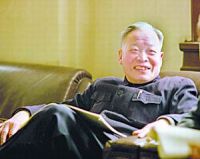Qian Sanqiang
Qian Sanqiang (Chinese: 钱三强), born in Shaoxing, was a famous scientist in nuclear physics and academician of the Chinese Academy of Sciences (CAS).
He graduated from the Department of Physics of Tsinghua University in 1936, and then went for France to engage in nuclear physics research at the Sorbonne and Collège de France in succession, where he obtained his doctorate. In 1946, he received the Prix Henri de Parville from the French Academy of Sciences. Qian returned to China in 1948 and joined the CPC in 1954. He served successively as professor of the Department of Physics in Tsinghua University, director of Atomic Energy Research Institute under the Central Academy of Beiping, director of the Institute of Modern Physics under CAS, director and vice secretary-general of the Planning Bureau, vice-president of CAS, director-general of the Chinese Physical Society, honorary director-general of the Chinese Nuclear Society and special advisor to CAS.
Qian was one of the founders of domestic nuclear industry. Under his leadership, China in the 1950s built its first heavy water reactor and first cyclotron, thus launching its research work in reactor physics, reactor engineering technology, radiobiology, radioactive isotope preparation, high energy accelerator technology and controlled thermonuclear fusion. After the Soviet Union ceased giving China any technological support, Qian immediately selected a group of excellent nuclear scientists and sent them to key positions in the No.2 Machinery Industry Ministry to be responsible for atomic bomb research. At the same time, he cooperated with CAS leaders to solve key problems, making great contributions to the birth of China's first atomic and hydrogen bombs. As early as 1960, he organized experimental groups to start research on a hydrogen bomb, laying the theoretical foundation for the technology. As a result, China succeeded in developing its first hydrogen bomb 32 months after exploding its first atomic bomb – an unprecedented achievement.
